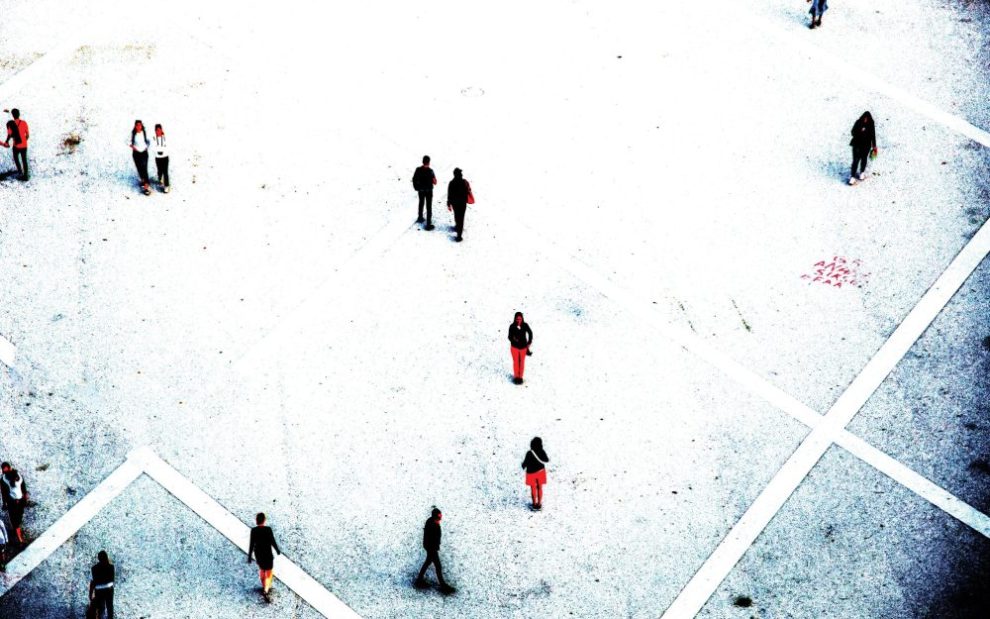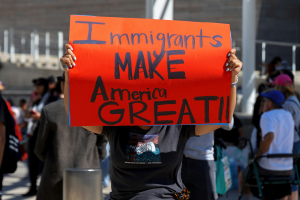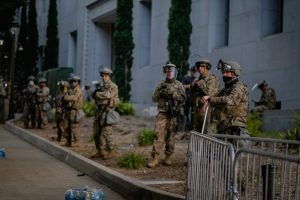As a history student at the University of Iowa, Evan Hudson did not expect his recreational experimentation with opioids to have long-term consequences. But then he moved to Vietnam to teach English and suffered a motorcycle accident. Opioids were easily accessible, and Hudson began self-medicating with heroin. “From that point on, I was fully in the grips of addiction,” he says. In 2016, Hudson moved back to the United States and got clean for a while. Then he relapsed, lost his job, and experienced homelessness. Finally, with the help of an organization that emphasizes harm reduction, he recovered.
Rather than requiring immediate abstinence from drug use, harm-reduction approaches aim to keep active users safer by offering clean needles, providing HIV testing, and distributing naloxone (Narcan) to reverse overdoses.
“The core of harm-reduction work is recognizing dignity in every single person,” says Hudson. While still in recovery, he took a job teaching English as a Second Language (ESL) at Divine Word Catholic Seminary in Dubuque, Iowa; he also began volunteering for Dubuque Harm Reduction, which he now leads. “It’s not too big of a stretch to say the harm-reduction work is spiritual in nature, and it is very much in line with a solidarity-based, works-based practice of spirituality,” he says. “We are literally resurrecting people, and it is a work of mercy.”
According to the U.S. Centers for Disease Control and Prevention (CDC), the ongoing U.S. opioid epidemic began in the late 1990s with increased opioid prescription for pain, leading to widespread addiction and overdose death. A second wave of the epidemic began in 2010 with increases in heroin addiction, followed in 2013 by a third wave, which was dominated by synthetic opioids mixed with illicitly manufactured fentanyl. The CDC reports that between 1999 and 2021, nearly 645,000 people died from opioid overdoses. According to the U.S. Department of Health and Human Services, the opioid epidemic has only worsened since the COVID-19 pandemic began; as of December 2023, more than 130 overdose deaths occur daily throughout the United States.
In recent decades, the Catholic Church has responded to many social and moral issues affecting this country—but its response to the ongoing opioid crisis has been spotty at best. Some Catholic leaders are calling for this to change.
For Catholic lay leader Keaton Douglas, the moral imperative is self-evident. Douglas, a professor of continuing education at Seton Hall University in New Jersey, is the founder of iTHIRST (The Healing Initiative—Recovery, Spirituality, Twelve-step), an initiative of the Missionary Servants of the Most Holy Trinity aimed at preventing and treating addictions. Initially piloted in the Archdiocese of Boston, the program now exists in parishes throughout the United States. “The numbers mean that [addiction] is in every school, every parish, and every neighborhood,” Douglas says. “There is no social issue affecting us more than addiction.”
How America became addicted
To discern a Catholic response to this epidemic, we must understand the root causes of the problem. Some media outlets focus the blame for escalating opioid and fentanyl crises on Chinese production and Mexican cartels. Nevertheless, according to the Council on Foreign Relations, nearly 90 percent of fentanyl traffickers are U.S. citizens. While supply and availability do influence opioid consumption, the United States is by far the largest global consumer. In addition to noting the overprescription of opioids in the 1990s that sparked the problem, experts see the root causes in political, economic, and social factors.
“Politically, I’d say the War on Drugs has caused the opioid addiction crisis,” Hudson says. “The legislation that treats drugs as a criminal issue rather than a public health issue makes the problem worse. People in power did this to create an internal enemy, which ends up worsening the problem and causing generational trauma, which in turn causes more addiction.”
Douglas agrees that the 50-year War on Drugs has failed. “We have penalized people instead of walking with them,” she says, noting that this has disproportionately affected communities of color.
In terms of economic and social factors, Hudson cites the despair caused by poverty and isolation. “If we look at the economic trends of the last decades, opportunity is kept behind class barriers. . . . With the increased poverty comes increased despair, which is a mental health issue,” he says. “Meanwhile, the increased atomization of people, the loss of community structures and meaning—such as the decline in church membership—makes people more depressed. They self-medicate due to trauma.”
Rashone Scott-Williams, who founded and leads Western New York Mobile Overdose Prevention Services (WNY Mobile OPS), a harm-reduction program based in Buffalo, New York, notes stigma and lack of education as additional causes of the crises. These are particularly prevalent in the communities of color that her organization primarily serves. Scott-Williams, who lost five family members to opioid overdoses in 2023 and recently saved the life of her own nephew, says she loves saving lives and seeking to educate her community.
“Miseducation is a problem impacting the African American community. When crack cocaine infiltrated our communities, addiction wasn’t seen as a disorder. It was a crime,” she says, referring to the Anti-Drug Abuse Acts of 1986 and 1988, which punished possession of crack cocaine a hundred times more severely than that of powder cocaine. This disproportionately affected Black communities, where crack was more prevalent.
“Now we have learned a different language, seeing addiction as a disorder of the brain,” she says. “We’re working to change the language and have African Americans understand it’s a brain-chemistry change within them or their loved ones. But this is a conversation that has never been had. It was not addressed to the African American community, so there is stigma.”
Scott-Williams—who operates the organization on a shoestring budget, using her personal vehicle to distribute Narcan and fentanyl testing strips—sees a lack of investment in Black communities as contributing greatly to the problem. “Often when a larger organization delivers services to our communities, the service providers don’t look like the people who are disproportionately affected,” she says. “When I’m doing my street outreach, I have people come up to me and say they wish they’d had information sooner.”
The harm-reduction approach, which involves serving active users, means she goes into areas most organizations don’t; she even has relationships with drug dealers. “They may be our most powerful allies,” she says. “If they have access to Narcan and fentanyl testing strips, they can test their drug before they serve it. They’re buying it from a distributor. They may not know fentanyl is in their cocaine. If I can have that relationship with a known drug dealer, to test the drug before giving it out and serving it to the community, that can make a difference. I’m not here to judge. I’m here to help.”
Scott-Williams has recently expanded WNY Mobile OPS from the Buffalo area to surrounding rural areas, where she notices different problems. “[Rural communities] don’t have access to traditional harm-reduction programs. They have urgent-care centers but limited medical services,” she says. This need has led her organization to expand from urban to rural areas, where they are placing Narcan kits in stores and seeking to educate the public.
“In rural areas, a main difference is the secrecy and stigma,” Scott-Williams says. “People are cut off from their communities and try to keep it a secret. In urban areas, what comes to mind is the frequency of interactions with the criminal justice and health care systems, where stigma is reinforced.”
While many Catholic charitable organizations focus on alleviating both urban and rural poverty, more work is needed to initiate a comprehensive response to the opioid crisis, which intersects with poverty, lack of economic opportunity, social isolation, and the legacy of racial injustice. But not all experts agree on what an appropriate response should look like.
Hope and healing
Hudson believes that a harm reduction approach is the most effective. “Actual chronic addiction is characterized by people continuing to use even if it has negative impacts on their lives,” Hudson says, recalling his own experience. “I knew I shouldn’t be smoking heroin in the restroom of an elementary school. I did it because if I didn’t, I’d be sweating, nauseous, suffering—I didn’t perceive it as a choice. I was more dependent on it than food.”
For Hudson, the focus on compassion rather than judgment is what makes harm reduction more effective than abstinence-only approaches. He says that when he attended Narcotics Anonymous and Alcoholics Anonymous meetings, he felt shamed and marginalized when he failed to meet the programs’ standards of abstinence. “I was told that unless you are completely abstinent, you’re not ‘clean’—you’re ‘dirty.’ Think of that language,” he says. “What if you try to reduce your usage, then switch to suboxone or methadone, then eventually move away from the drugs? Treating some people as not worthy of positive regard causes harm.”
Douglas, meanwhile, strongly advocates for the 12-step approach, which forms the basis for iTHIRST’s work. “I defer to the work of Dr. Gerald G. May, a psychiatrist who understood the disease of addiction as an attachment disorder,” she says. “There might be things we don’t desire but don’t know how to give up: an unnatural attachment to food or a desire to compete with others. These become acute and keep us from family, from self-care, from developing an intimacy with the God of our understanding, which for Catholics is our triune God.”
For Douglas, 12-step and harm-reduction approaches need not be mutually exclusive. “We make an unnatural debate. I’m not going to give you a needle and walk away. We want to get to the root of the pain and walk with you. . . . Harm reduction can be a good thing, but as it’s often proposed, it’s not enough.”
Public policy is another crucial step toward solving the opioid crisis. Jeff Reynolds, who is president and chief executive officer of the Family and Children’s Association on Long Island, agrees with Hudson and Douglas that the War on Drugs has failed. “Our drug policy is almost always to chase the drug of the day—whether heroin, then fentanyl, and most recently xylazine. We never get to the core: the mental health issues that drive addiction,” he says. Reynolds notes that sales of alcohol and marijuana have also increased since the COVID-19 pandemic, and he sees the lack of access to mental health treatment as a significant part of the problem.
At the policy level, Reynolds successfully advocated for the passage of the 911 Good Samaritan Law in New York State (which allows people to call for medical help when someone is overdosing without facing arrest for their own drug use or possession) and I-STOP (a prescription-monitoring program that tracks down corruption within the health care system). He currently is advocating for insurance parity laws—which make insurance companies cover mental health and addiction treatment—as well as a bill that would treat as crime victims people who experience fentanyl overdoses. “I bristle when people talk about fentanyl overdoses. Most people are buying pills on the street because they can’t get an appointment with a psychiatrist, and they don’t know fentanyl is in them. Those aren’t overdoses. They’re poisonings,” Reynolds says.
As Reynolds continues to work on the opioid crisis, he expresses concern that current political polarization is undermining efforts. “In the past, we stood united against opioid addiction, in addressing heroin. There’s a fracture related to fentanyl, border security, and what an appropriate policy looks like,” he says. “It’s easy to blame Mexico or China—where much of it comes from—but we have a lot of domestically produced drugs too. I worry that the current foreign-policy emphasis is reverting us back to penalizing drugs rather than creating treatment opportunities.”
A Catholic response
Catholic social teaching stresses the dignity of human beings and a preferential option for the poor and vulnerable. But Keaton Douglas, who is working to implement the iTHIRST initiative in parishes nationwide, argues that current efforts on the part of Catholics are not enough.
“Some churches have AA or NA meetings, which is marvelous. But unless you invite people into the sanctuary to participate, it’s just a room rental,” Douglas says. “We need boots on the ground. People should be able to knock on the door of any Catholic parish and know someone is there to help with spiritual consolation and recovery resource information.”
Douglas believes that the reason for a lack of Catholic action on this issue has been stigma and a misunderstanding of the spiritual roots of addiction. In addition to exporting the iTHIRST program to 30 states, as well as overseas, Douglas has called for ordinary Catholics to be more mindful of this issue. “Ask your parish priest to include people suffering from addiction in the Prayers of the Faithful. Ask your Rosary Society or other parish prayer groups to organize a prayer service for Overdose Awareness Day on August 31, or celebrate September as Recovery Awareness Month,” she says. “Place pamphlets from NA or AA in the gathering spaces or at the food pantry. . . . When people know the church is welcoming and will welcome them with the love of Christ, they will come back.”
While there is no unified, concerted Catholic response to opioid addiction at the national level, many communities are striving to do the work on the ground. Project SafePoint is a Catholic Charities-sponsored harm-reduction syringe-exchange program in New York State that, according to the organization’s website, “uses harm reduction as a means to not only prevent disease transmission, overdose, and other negative consequences of drug use, but as a way to develop non-judgmental, meaningful relationships with people who use drugs.” These relationships can form the basis of healing.
Meanwhile, one Catholic group that has implemented the iTHIRST program is the Community of Jesus Crucified in St. Martinville, Louisiana. They run a soup kitchen, food pantry, two youth programs, and two sober-living houses—the only ones in Louisiana that require no payment.
Eric Greenwood, who volunteers in the program, has two sons in recovery from opioid addiction, while he himself is in recovery from alcoholism. He believes that ongoing stigma is one reason for the lack of a concerted Catholic response.
“A lot of people don’t understand that addiction is a disease, a malady that affects the mind, body, and spirit. When Purdue Pharma started promoting OxyContin in the 1990s, people did not know the effects,” Greenwood says, arguing that while the stigma has affected his family, he sees his and his sons’ recovery as a blessing. “I learned a closer relationship with God, that I was searching for something spiritually.”
Community of Jesus Crucified Brother Bernard Boudreaux, who administers the program, would like to see the Vatican issue a document on addiction. “There are times when opioids can be used medically, but overconsumption impedes human dignity,” he says. “But while Rome can give counsel and direction, it’s up to us to live it out at the local level. Priests in formation need to understand addiction. Parishes need a team or task force that can help people who struggle.”
The Glenmary Missioners—priests and brothers who work in parts of the rural United States where Catholics are a minority—also seek to respond to the opioid crisis when they encounter it in their communities. Brother Jason Muhlenkamp joined Glenmary in 2008 after recovering from alcohol addiction, and he has served in Blakely, Georgia since 2015. Like most of the United States, this region, where 30 percent of the population lives below the poverty line, has been hit hard by the opioid and fentanyl crises. Soon after his arrival, Muhlenkamp teamed up with a Baptist minister to set up transitional housing for people with addictions. In 2019, they founded C-HOPE Ministries (“C” stands for “Christ-Centered”), which incorporates both 12-step and harm-reduction approaches.
“When I give mission appeals for Glenmary, I tell stories about helping people with their addictions. People always come up to me afterwards and share their personal stories of family members. I don’t hear that much about this in the Catholic Church coming from the top,” he says, adding that many of the Protestant leaders he works with have also been unresponsive. “I believe that hearing people’s stories reduces stigma. Some critics of our program accuse us of wasting our time with people. But a Glenmary priest I admire once said we should waste more time with people. That is what I am trying to do.”
Rashone Scott-Williams notes that one of the most successful community outreach events she organized for WNY Mobile OPS was held at St. Joseph University Parish at the University of Buffalo. “The room was packed. The priest and parish staff invited everyone. It was one of our largest events,” she says.
People who work to accompany people with opioid addiction share a deep awareness of our human brokenness and a belief in the healing power of a loving God. “I dropped out of school at 16,” Scott-Williams says. “Then I got my GED and learned I was smart. I went to college and obtained a master’s. My story is motivational for people who don’t know they can make it. I was born legally blind and have a mental health diagnosis. People need to know that substance abuse or mental health doesn’t determine you.”
Soon after the dissolution of Keaton Douglas’ marriage left her angry and bitter, she was invited to lead a retreat for women in recovery from various addictions. This led to her founding iTHIRST. “I learned that anything can break us, and we can all accompany one another,” she says. “Losing work, losing a marriage, worrying about a child with the disease of addiction—it’s all brokenness. But in that brokenness, we can walk together and get spiritual healing.”
In calling for a Catholic response, Evan Hudson recalls that the word catholic means universal and inclusive. “This is one of the most beautiful parts of Catholicism,” he says. “Support is what breaks the addictive feedback loops. It can be a group of fellow recovering addicts, trained professionals, family, friends, and other people who share common goals. The opposite of addiction is community.”
This article also appears in the April 2024 issue of U.S. Catholic (Vol. 89, No. 4, pages 26-30). Click here to subscribe to the magazine.
Image: Pexels/Ryutaro Tsukata















Add comment